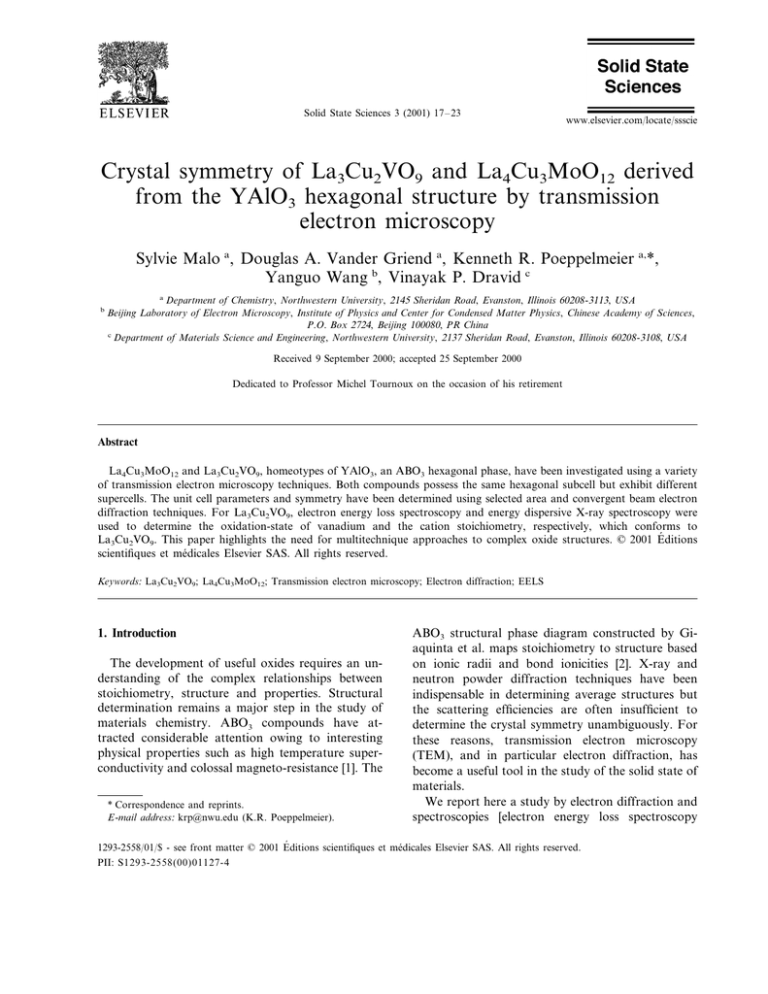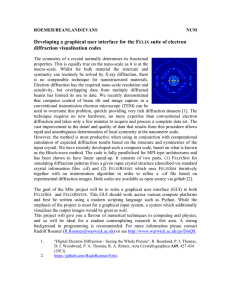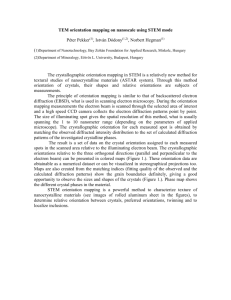
Solid State Sciences 3 (2001) 17 – 23
www.elsevier.com/locate/ssscie
Crystal symmetry of La3Cu2VO9 and La4Cu3MoO12 derived
from the YAlO3 hexagonal structure by transmission
electron microscopy
Sylvie Malo a, Douglas A. Vander Griend a, Kenneth R. Poeppelmeier a,*,
Yanguo Wang b, Vinayak P. Dravid c
a
b
Department of Chemistry, Northwestern University, 2145 Sheridan Road, Evanston, Illinois 60208 -3113, USA
Beijing Laboratory of Electron Microscopy, Institute of Physics and Center for Condensed Matter Physics, Chinese Academy of Sciences,
P.O. Box 2724, Beijing 100080, PR China
c
Department of Materials Science and Engineering, Northwestern University, 2137 Sheridan Road, Evanston, Illinois 60208 -3108, USA
Received 9 September 2000; accepted 25 September 2000
Dedicated to Professor Michel Tournoux on the occasion of his retirement
Abstract
La4Cu3MoO12 and La3Cu2VO9, homeotypes of YAlO3, an ABO3 hexagonal phase, have been investigated using a variety
of transmission electron microscopy techniques. Both compounds possess the same hexagonal subcell but exhibit different
supercells. The unit cell parameters and symmetry have been determined using selected area and convergent beam electron
diffraction techniques. For La3Cu2VO9, electron energy loss spectroscopy and energy dispersive X-ray spectroscopy were
used to determine the oxidation-state of vanadium and the cation stoichiometry, respectively, which conforms to
La3Cu2VO9. This paper highlights the need for multitechnique approaches to complex oxide structures. © 2001 Éditions
scientifiques et médicales Elsevier SAS. All rights reserved.
Keywords: La3Cu2VO9; La4Cu3MoO12; Transmission electron microscopy; Electron diffraction; EELS
1. Introduction
The development of useful oxides requires an understanding of the complex relationships between
stoichiometry, structure and properties. Structural
determination remains a major step in the study of
materials chemistry. ABO3 compounds have attracted considerable attention owing to interesting
physical properties such as high temperature superconductivity and colossal magneto-resistance [1]. The
* Correspondence and reprints.
E-mail address: krp@nwu.edu (K.R. Poeppelmeier).
ABO3 structural phase diagram constructed by Giaquinta et al. maps stoichiometry to structure based
on ionic radii and bond ionicities [2]. X-ray and
neutron powder diffraction techniques have been
indispensable in determining average structures but
the scattering efficiencies are often insufficient to
determine the crystal symmetry unambiguously. For
these reasons, transmission electron microscopy
(TEM), and in particular electron diffraction, has
become a useful tool in the study of the solid state of
materials.
We report here a study by electron diffraction and
spectroscopies [electron energy loss spectroscopy
1293-2558/01/$ - see front matter © 2001 Éditions scientifiques et médicales Elsevier SAS. All rights reserved.
PII: S1293-2558(00)01127-4
18
S. Malo et al. / Solid State Sciences 3 (2001) 17–23
(EELS) and energy dispersive X-ray spectroscopy
(EDS)] performed on two samples, La4Cu3MoO12
and La3Cu2VO9.
2. Experimental
The molybdenum and vanadium cuprates,
La4Cu3MoO12 and La3Cu2VO9, were prepared as
previously reported, starting from the stoichiometric
ratio of La2O3, CuO, MoO3 and VO2, fired at high
temperature and slowly cooled to room temperature
[3,4].
For the TEM study, the samples were crushed in
alcohol and the small flakes deposited on holey
carbon grids. The electron diffraction was performed
on a Hitachi-8100 operated at 200 kV. The spectroscopy studies were carried out on a Hitachi
HF2000 equipped with a cold-field emission gun.
The cationic composition was verified by EDS performed with Oxford’s Pentafet Link detector with
QX2000 processor/system. The EELS spectra were
acquired at 200 kV with a Gatan 666 parallel spectrometer in diffraction mode. The energy resolution
of the spectrometer is around 0.5 eV (full width at
half maximum).
Based on specific SAED patterns, the reciprocal
space is reconstructed which gives the extinction
conditions and the lattice parameters. Convergent
beam electron diffraction (CBED) is characterized
by a relatively small-converged beam. Three different
types of CBED patterns can be obtained depending
on the camera length and the beam focus: the zero
order Laüe zone (ZOLZ), the high order Laüe zone
(HOLZ) and the whole pattern. The ZOLZ patterns,
recorded using a medium camera length, exhibit for
some zone axes the Gjønnes-Moodie (G-M) lines
from which additional translation symmetry elements such as screw axes and glide planes can be
deduced [6]. With a small camera length, CBED
patterns exhibit the HOLZ rings, from which the
unit cell can be determined. Whole patterns (WP),
recorded using a small camera length and a small
convergence of beam, evidence mirror planes. Together these diffraction techniques can be used to
determine the symmetry and space group of new
compounds.
The SAED patterns for both La4Cu3MoO12 and
La3Cu2VO9 show a set of intense diffraction spots
characteristic of the hexagonal subcell (see Fig. 7,
3. Results and discussion
The powder X-ray diffraction (XRD) data did not
show any impurity phases either for the molybdate
or the vanadate sample. Their XRD patterns resemble that of YAlO3 with additional reflections (Fig. 1)
[5]. Therefore, in order to determine the supercell
with the cell parameters and symmetry, we have
performed a complete structural characterization by
electron diffraction.
The TEM study is performed on very small crystallites from powder samples and does not require
large single crystals. TEM can be used in two major
modes: diffraction and image. Using the TEM in
diffraction mode allows 2D diffraction patterns to be
recorded. The beam size, the beam convergence and
the camera length, are three different parameters
that can be adjusted to obtain different electron
diffraction patterns, which provide different information concerning the crystal symmetry. The selected area electron diffraction (SAED) is
characterized by a large parallel incident beam.
Fig. 1. Powder X-ray pattern for (a) La4Cu3MoO12, and (b)
La3Cu2VO9. Arrows mark superstructural peaks.
S. Malo et al. / Solid State Sciences 3 (2001) 17–23
19
representing La3Cu2VO9 pattern) (a: 4 A, and c:
11 A, ) classically observed for the rare earth hexagonal YAlO3 structure type. However, extra, weaker
reflections for both samples are also systematically
observed.
3.1. La4Cu3MoO12
For the molybdate sample, the additional reflections, which are not compatible with hexagonal symmetry, define a monoclinic or orthorhombic cell with
a:8 A, , b: 7 A, :4.0
3, c: 11 A, and k :90°.
The reconstruction of reciprocal space based on
collecting specific SAED patterns indicated only one
condition for forbidden reflection: 00l: l"2n. This
extinction condition for a monoclinic or orthorhombic symmetry implies a 21-screw axis along the caxis. Therefore, according to the international tables
for crystallography [7], the possible space groups are
P1121, P1121/m and P2221. Fig. 2 shows [100], [21( 0]
and [010] SAED patterns.
Additional symmetry elements such as screw axes
and mirror planes were deduced from a CBED study
by observing the G-M lines and by determining WP
symmetries, respectively [8,9]. The G-M lines refer to
the dynamical absences in the kinetically forbidden
reflections and appear as dark bands or crosses in
some kinematically forbidden reflections, shown
schematically in Fig. 3. Dark bands indicate that the
electron beam is either parallel to a glide plane or
Fig. 2. SAED patterns of La4Cu3MoO12 oriented (a) [100], (b)
[21( 0], and (c) [010].
Fig. 3. Schematic representation of G-M lines (a) indicating a
screw axis perpendicular to the beam (b) black crosses indicating
forbidden reflections.
20
S. Malo et al. / Solid State Sciences 3 (2001) 17–23
3.2. La3Cu2VO9
Unlike the molybdate compound, thermogravimetric analysis (TGA) could not be used to successfully determine the stoichiometry of the vanadate
sample owing to the ambivalence of the oxidation
state of vanadium. EDS was used to ascertain the
cationic ratio and EELS to determine the vanadium
oxidation state after synthesis (vanadium(IV) oxide
was used as starting material).
EDS analyses established the cationic ratios La:V
of 2.9(2) and Cu:V of 1.99(9) in agreement with the
synthetic composition.
The EELS spectra were recorded at the L3/L2 edge
of vanadium. For this study, we focused on the
high-loss regions, which contain the vanadium L2,3
peaks and oxygen K peak (Fig. 5). The vanadium L2
and L3 peaks represent electronic transitions from
vanadium 2p1/2 and 2p3/2 states to molecular orbitals
with 3d character [11]. The oxygen k-edge, which
spreads between 525 and 550 eV, represents transition from the oxygen 1s state to molecular orbitals
with oxygen 2p character. At higher energy, we
observe the lanthanum M4,5 peaks (Fig. 6). Previous
studies reported that the L3 /L2 ratio increases as the
Fig. 4. [010] CBED pattern of La4Cu3MoO12. (a) ZOLZ pattern.
The black arrows indicate the G-M lines visible in the 00l discs for
l odd. (b) Whole pattern exhibiting a mirror plane perpendicular
to the c-axis.
perpendicular to a screw axis in the crystal, and the
black crosses refer to forbidden reflections.
The ZOLZ-CBED pattern taken along the [010]
zone axis shows G-M lines in the 00l discs for l odd,
indicated by black arrows on Fig. 4(a). According to
the tables established by Steeds et al. [10], the G-M
lines confirm the presence of a 21 screw axis parallel
to the c-axis and the forbidden reflections (00l:
l "2n). Again, the three possible space groups are
P1121, P1121/m and P2221, the [010] WP exhibits a
mirror plane (Fig. 4(b)) perpendicular to the c-axis,
which indicates that P1121/m (no. 11) is the correct
space group.
Fig. 5. The region from 500 to 550 eV in energy loss spectra of (a)
Mg3V2O6, (b) La3Cu2VO9 and (c) Mg3V2O8.
S. Malo et al. / Solid State Sciences 3 (2001) 17–23
Fig. 6. The region from 800 to 900 eV in energy loss spectra of
La3Cu2VO9.
Table 1
Experimental values for the ratios between background-subtracted, integrated intensities of V L3 and V L2 peaks
Phase
V L3/L2
Mg3V2O6
Mg3V2O8
La3Cu2VO9
0.90(8)
0.72(4)
0.69(6)
oxidation states of transition metals such as vanadium and manganese decreases and therefore can be
used to determine the oxidation state of cations in 3d
transition metal-oxides [12,13]. In order to determine
the oxidation state of vanadium in our sample, the
spectra at the L3/L2 edge were recorded for Mg3V2O6
and Mg3V2O8 where vanadium exhibits the + 3 and
+5 oxidation states, respectively [14]. In both magnesium vanadium oxides, the vanadium oxidation state
was also evidenced by XRD and IR studies. All
spectra were obtained from 500 to 550 eV integrated
using Peakfit4® program. The L3/L2 ratio obtained
for La3Cu2VO9, Mg3V2O6 and Mg3V2O8 are listed in
Table 1. The values obtained for La3Cu2VO9 are
equal within the experimental error to the ones
obtained for Mg3V2O8 and indicate that vanadium is
in the +5 oxidation-state. The EELS study, com-
21
bined with the EDS results, confirms the stoichiometry La3Cu2VO9 for the hexagonal phase.
With the confirmation of the stoichiometry, we
now deal with the structural study. For the vanadate
sample, the system of additional spots implies a new
hexagonal cell with a: 14.4 A, and c: 10.7 A, , which
was previously reported by Jansson et al. [15].
The HOLZ rings, observed on CBED patterns,
were used to verify the supercell. The real lattice
spacing (H −m1) parallel to the beam direction can be
expressed by the measured radius of the HOLZ ring
r (mm) and the camera constant uL (nm mm):
H −m1 =
2
u
uL
r
2
(1)
This value can be compared to the theoretical one
(H −c 1) calculated from equations developed from reciprocal lattice theory [16,17]. For hexagonal
systems:
H −c 1 = (a 2(U 2 +V 2 −UV)+ c 2W 2)1/2
(2)
The calculated value H −c 1 must be an integer multiple (n) of the measured spacing H −m1, where n
represents the order of the Laüe zone:
H −c 1 = n×H −m1
(3)
Table 2 lists the measured and calculated H – 1
based on the hexagonal supercell. The agreement
between the values confirms the validity of our
hexagonal cell and indicates that a larger supercell is
not merited.
The reconstruction of the reciprocal space deduced
from many SAED patterns obtained by tilting along
the a* and c* axes indicated only one condition for
forbidden reflections, 000l: l" 2n. In hexagonal systems, this extinction condition represents a 63-screw
axis along the c direction and therefore three space
groups are possible: P63, P63/m and P6322. Fig. 7
exhibits the [0001], [112( 0] and [11( 00] SAED patterns.
Table 2
Calculated and measured layer spacings (H–1) from CBED patterns
Crystal orientation
Laüe zone order (n)
Calculated H−1
(nm)
c
Measured H−1
m (nm)
21( 0
112
114
31( 0
11( 0
1
1
1
1
1
3.81
2.58
4.5
5.2
2.49
3.80(6)
2.58(5)
4.6(2)
5.1(2)
2.49(3)
22
S. Malo et al. / Solid State Sciences 3 (2001) 17–23
Fig. 8. [11( 00] zone-axis whole pattern from La3Cu2VO9 showing
the mirror plane perpendicular to the c-axis.
The 000l spots with l odd are weakly visible in some
SAED patterns (indicated by small arrows on Fig.
7(b)) owing to dynamical scattering events, commonly called double diffraction.
The three possible space groups correspond to the
point groups 6, 6/m and 622, respectively, which are
characterized by three distinct WP symmetries [18].
The WP taken along [11( 00] shows a mirror plane
perpendicular to the c-axis (Fig. 8), so the correct
space group is P63/m.
4. Conclusion
Fig. 7. (a) [0001], (b) [112( 0] and (c) [11( 00] SAED patterns of
La3Cu2VO9. The small arrows on Fig. 2(b) indicate forbidden
spots visible owing to double diffraction.
The symmetry and the lattice parameters of
La4Cu3MoO12 and La3Cu2VO9 have been determined unambiguously from electron diffraction microscopy. Thus, La4Cu3MoO12 crystallizes in a
monoclinic cell with a: 8 A, , b: 7 A, : 4.0
3, c:
11 A, , k :90° and P1121/m symmetry, and
La3Cu2VO9 in a hexagonal cell with a:14.4 A, ,
c: 10.7 A, and P63/m symmetry. For the latter
compound, related spectroscopy studies (EDS and
EELS) confirm the composition of the hexagonal
phase and evidenced the +5 oxidation-state of vanadium. Knowing the unit cell parameters, symmetry
and composition has led to the successful determination of the atomic positions by Rietveld method
from X-ray or neutron powder diffraction data [3,4].
This study underscores the need for diverse transmission electron microscopy techniques in unraveling
complex oxide structure.
S. Malo et al. / Solid State Sciences 3 (2001) 17–23
Acknowledgements
We would like to thank Luke Brewer for his help
in collecting the CBED pattern. This work is supported by a National Science Foundation (NSF)
graduate fellowship for DAVG, by National Science
Foundation (Award No. DMR-9120000) through
the Science and Technology Center for Superconductivity, and made use of the Central Facilities at the
Materials Research Center of Northwestern University (NSF Award No. DMR-0076097). VPD was
partially supported by US DOE Grant No DEFGOZ-92ER45475.
References
[1] C.N.R. Rao, J. Mater. Chem. 9 (1999) 1.
[2] D.M. Giaquinta, H.-C. zur Loye, Chem. Mater. 6 (1994) 365.
[3] D.A. Vander Griend, S. Boudin, V. Caignaert, K.R. Poeppelmeier, Y. Wang, V.P. Dravid, M. Azuma, M. Takano, Z.
Hu, J.D. Jorgensen, J. Am. Chem. Soc. 121 (1999) 4787.
.
23
[4] D.A. Vander Griend, S. Malo, S. Barry, N. Dabousseh, K.R.
Poeppelmeier, V.P. Dravid, Solid State Sciences, submitted.
[5] F. Bertaut, J. Mareschal, Compte Rendu des Sciences 257
(1963) 867.
[6] J. Gjønne, A.F. Moodie, Acta Cryst. 19 (1965) 65.
[7] T. Hahn, International Tables for Crystallography. D. Reidel
Publishing Company: Dordrecht, (1983)
[8] J. Gjønne, A.F. Moodie, Acta Cryst. 19 (1965) 65.
[9] D.B. Williams, C. Barry Carter, Transmission Electron Microscopy, Plenum Press, Chapter 21 (1996) 319.
[10] J.W. Steeds, R. Vincent, J. Appl. Cryst. 16 (1983) 317.
[11] C.C. Ahn, O.L. Krivanek, EELS Atlas (Center for Solid
State Science, Arizona State university, Tempe, AZ) (1983).
[12] X.W. Lin, Y.Y. Wang, V.P. Dravid, P.M. Michakalos, M.C.
Kung, Phys. Rev. B 47 (1993) 3477.
[13] J.H. Rask, B.A. Miner, P.R. Buseck, Ultramicroscopy 21
(1987) 321.
[14] X. Wang, H. Zhang, W. Sinkler, K.R. Poeppelmeier, L.D.
Marks, J. Alloys Comp. 270 (1998) 88.
[15] K. Jansson, I. Bryntse, Y. Teraoka, Mater. Res. Bull. 31
(1996) 827.
[16] M. Raghavan, J.C. Scanlon, J.W. Steeds, Met. Trans. 15A
(1984) 1299.
[17] R. Ayer, J. Electron Microsc. Tech. 13 (1989) 16.
[18] B.F. Buxton, J.A. Eades, J.W. Steeds, G.M. Rackham, Phil.
Trans. Roy. Soc. 281 (1976) 181.



